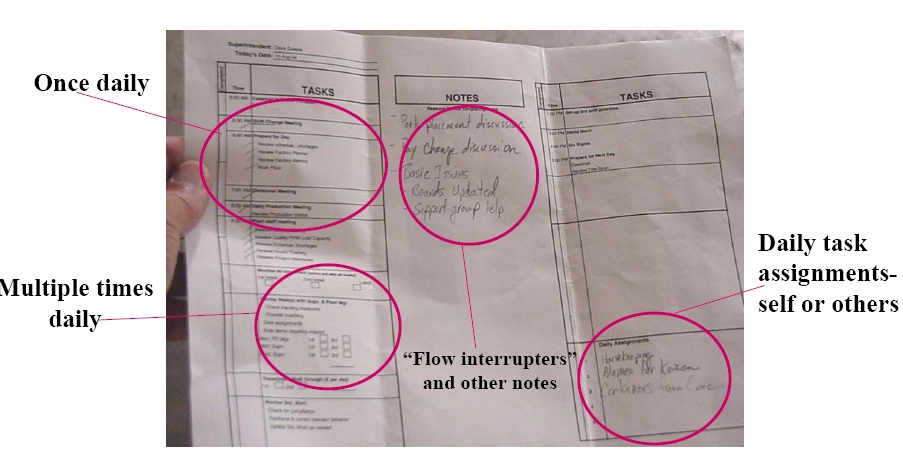Leader Standard Work is a critical step in ensuring that the Lean Culture in your organization prospers. But, Leader Standard Work is dependent on a few things. In what follows, I’ll cover a few of those items and provide an example of Leader Standard Work. For a primer on the importance of Standard Work, check out the Standard Pig Game, an interactive game that teaches the importance of Standardized Work.
Leader Standard Work is meant to accomplish the following:
- Clear expectations for leading lean
- Focused on behavior
- What you want leaders to do
- Do first, know second -if have to choose
- What you can see leaders doing -or not!
- More coachable, teachable
- More readily changed
- Improved odds for successful transition
David Mann, a respected author who has written about how to effectively create a Lean Culture in your organization believes that a Lean Culture is dependent on 3 things:
- Leader Standard Work
- Visual Management
- Daily Accountability
Leader Standard Work
Leader Standard Work is, seemingly, redundant. But that’s part of its beauty. Because it is the same exercise, it also creates a robustness to our processes that unlike anything else can accomplish.
For different leaders in the organization, the typical breakdown of standard work might be in the following:
- Team Leader Standard Work
- Supervisor Leader Standard Work
Team Leader Standard Work
Team Leader standard work accounts for approximately 80% of Team Leader’s time
Once a Day Items
- Lead team startup meeting
- Review, adjust labor plan
- Monitor production start up
- Post tracking sheets
- Attend dept board’ meeting
- Complete improvement task assignments
- Work on improvement
- Set next day labor plan
- Update Pareto charts
Multiple Times a Day
- Observe std work each station
- Update performance tracking each pitch
- Monitor start, stop times
- Train operators as needed
Supervisor Leader Standard Work
Supervisor standard work accounts for approximately 50% of supervisors’ time
Once a Day Items
- Meet w/ opposite shift
- Monitor production startup
- Lead dept board’ meeting w/ team leaders
- Attend VS board’ meeting
- Complete improvement task assignments
- Gemba walk a team leader
- In-depth monitor standard work one work station
- Opposite shift/next day plan
Multiple Times a Day Items
- Department walkthrough
- Review, initial tracking charts; action as needed
- Monitor start, stop times
- Monitor team leader standard work
Visual Management
Following Leader Standard Work, during your walk in the Gemba, will likely lead you to the Visual Controls. When there, look for:
- Production tracking charts, operator daily maintenance boards, 5-S daily task boards, between-process control boards, equipment calibration signoffs, etc.
- Visuals show expected versus actual
- Leader’s job at the visual:
- Verify tracking or execution
- Ensure misses/fallouts are clearly documented
- Ensure appropriate response to variances
- Visuals convert energy of leader std work into process focus –structured, documented
- Expected versus actual, reasons for variation
- Expected versus actual, executed or not
- Skipped, late, partial
- Documented process data gives traction leaders can use to drive improvement
Daily Accountability
A daily accountability process:
- Leader scrutinizes visuals’ data daily Determines what steps to take by whom
- Assigns resources, sets due dates
- Follows up
- Daily, tiered stand-up meetings
- Brief, on the floor
- Visual accountability
Looking at the above and the relationship between Leader Standard Work, Visual Controls, and Daily Accountability, shows a clear difference between what is known as “Management by Walking Around” versus “Gemba Walk”. This approach clearly shows respect for people, is standardized, is repeatable, and can help the organization scale.










Pete,
I’d like to read a post on leader standard work in an office, not a factory.
Hey Dan – I’d love to read a post on leader standard work in an office setting too – I look forward to you writing that one.
Guys – You have just highlighted the biggest problem people have with lean and six sigma: They think it only applies to manufacturing or factory settings. The truth is the same principles apply across all settings, you just need to change the words. Team Lead once a day items still happen in office settings: instead of production startup you have “begin payroll input” or “accounts receivable input”. You still post tracking sheets, not of the same items and maybe not physically, but it still happens. You still have standard work, the proper way to fill out forms or reports, and you still have to ensure your employees follow it. You still need visual management, whether it be posted on a wall or monitor, and this is where dashboards are universal in appeal for showing task status or completion. You can and should still have daily startup/standup meetings as well as expected vice actual progress tracking. An office is nothing more than a factory that produces paperwork/reports/memos instead of widgets.
Excellent Reply. You summed that up nicely. I think the problem people have with Lean in the office may be the applicability of a Gemba walk in an office. You may not need to sit down and watch an analyst perfrom a SQL query, but you could still develop a value stream map and observe how that query is used to support a report that ultimately travels from department A to department B, checking for quality standards and ensuring output meets customer requirements.